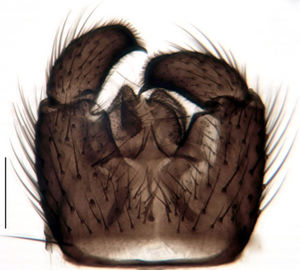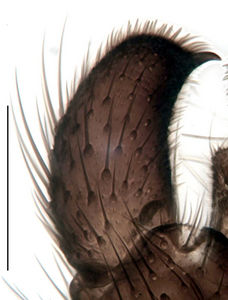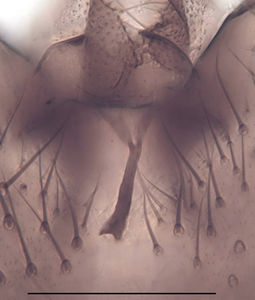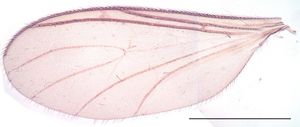Trichosiopsis defecta
Ordo: Diptera
Familia: Sciaridae
Genus: Leptosciarella
Name
Leptosciarella defecta (Strobl, 1910) – Wikispecies link – ZooBank link
- Sciara elegans var. defecta Strobl, 1910[1]: 233
- Leptosciarella (Leptosciarella) defecta (Strobl, 1910)
Type material
Holotype: ♂, leg. Strobl, in NMBA
Type locality
Austria, Styria, Kematenwald
Further material studied
Austria: 1 ♂, Styria, Gesäuse National Park, Johnsbach unterhalb Ebner (Wildgatter, Brunnen), Gerecke, 08.06.2010, PKHH 7744; 1 ♂, Quelle 4 östlich Kalktalbachbett, Gerecke, 29.05.2010, PKHH 7778 [both as Leptosciarella rejecta in Heller (2012[2]: 377, 378)]; Germany: 1 ♂, Bavaria, National Park Berchtesgaden, Sommerbichel, Quellbach S Herrenroint, Gerecke, 13.06.1994, PKHH 7662; 1 ♂, Rhineland-Palatine, Glashütte/Lemberg, Winterbergstollen, pitfall trap, Weber, 03.05.2003, PKHH 5486; 2 ♂, Saarland, Wallerfangen, Felsdach 2 im Blauwald, pitfall trap, Weber, 30.05.2003, PKHH 5490; 2 ♂, Saxony-Anhalt, Harz, Kyffhäuser, Uftrungrn, Heimhehle, pitfall trap, Eckert, 17.05.1989, PWMP 1631/1632 [as Leptosciarella rejecta in Mohrig & Menzel (1997[3]: 63)]; 1 ♂ 1 ♀ 04.10.1989, PWMP 4036; Luxembourg: 1 ♂ 1 ♀, Huldange, Kammer beim Bahntunnel Huldange, Weber, 19.05.2007, PKHH 5683; 1 ♂ 1 ♀, Minière Laangebierg Italien, Höhle, pitfall trap, Weber, 23.5.-19.08.1990, PKHH 7655; Sweden: 1 ♂, Ångermanland, Skuleskogen National Park, Langra: brook ravine in mixed forest, Malaise trap, Swedish Malaise Trap, 28.6.-05.07.2004, PKHH 7491; 1 ♂, Halland, Halmstad, Gardshult, Buskatycket; moist hay meadow, Malaise trap, Swedish Malaise Trap Project, 4.-15.08.2005, PKHH 6623; 7 ♂, Småland, Bäckebo, Grytsjöns naturreservat, Old aspen forest in boulder terrain, Malaise trap, Swedish Malaise Trap, 18.5.-15.06.2006, PKHH 6773/6780/6801, NHRS 2912/2923; 1 ♂, Grytsjöns naurreservat, Old moisty haymaking meadow in forest edge, Malaise trap, Swedish Malaise Trap, 4.-19.06.2005, PKHH 7503; 2 ♂, 18.5.-15.06.2006, PKHH 6830/6855; 1 ♂, Östergötland, Omberg, Storpissan: old Norway spruce wood, Malaise trap, Swedish Malaise Trap Project, 28.5.-05.07.2005, NHRS 2030-2040/2093/3564; 1 ♂, Svartlöga, Matkrok, maritime deciduos wood, Malaise trap, Swedish Malaise Trap Project, 19.7.-18.08.2005, PKHH 7422; 2 ♂, Småland, Bäckebo, Grytsjöns naurreservat, Old moisty haymaking meadow in forest edge, Malaise trap, Swedish Malaise Trap Project, 4.-19.06.2005, PKHH 7441/7506; 1 ♂, Gränna, Lönnemålen, next to old cellar; Norway spruce forest with big harvested ashes, Malaise trap, Swedish Malaise Trap Project, 15.6.-01.07.2005, PKHH 6712; 1 ♂, Södermannland, Nämdö, Krokudden, Krokvik, spruce and pine forest, Malaise trap, Swedish Malaise Trap Project, 5.7.-07.08.2008, PKHH 7356; 1 ♂, Södertälje, Tullgarns näs, Rävsalaviken, mixed forest next to pasture, Malaise trap, Swedish Malaise Trap Project, 3.7.-19.08.2004, PKHH 7486; 1 ♂, Torne lappmark, Abisko, birch forest, northern slope, yellow pan trap, Tschirnhaus, 13.-17.07.1991, PWMP 4042; 3 ♂, Uppland, Biskops-Arnö, northern beach, elm grove, Malaise trap, Swedish Malaise Trap Project, 20.6.-18.07.2005, PKHH 7389/7391; 15 ♂, Älvkarleby, Batfors, pine forest with blueberry, Malaise trap, Swedish Malaise Trap Project, 27.6.-01.07.2004, PKHH 7449-7452/7464-7469, NHRS 4594-4598; 3 ♂, Torne lappmark, Kiruna, Nikkaluokta, young birch/willow forest along stream, Malaise trap, Jaschhof & Jaschhof, 14.7.-05.08.2005, PKHH 5938, NHRS 1071/1075 [as Leptosciarella rejecta in Heller et al. (2008[4]: 40)]; Switzerland: 1 ♂, Zurich, Sihlwald, photoeclector, Schiegg, 25.4.-23.05.1996, PKHH 2478; 1 ♂, window trap, Schiegg, 24.5.-05.06.1996, PKHH 1812.
Description (male)
Head. Eye bridge 3–5 rows of facets. LW-index of 4th antennal flagellar segment 1.98–2.3; neck 0.25–0.38 of segment width; Transition of basal part to neck pronounced. Colour of neck unicolour. Antennal hairs shorter than segment width; dense; salient. Palps darkened; normal; palpomeres 3. First palpomere of normal shape; with 3–6 bristles; with only some sparse sensillae. Second palpomere shortly oval, or elongate. Third palpomere as long as first segment. Thorax. Colour brown, or reddish. Notum unicolorous. Thoracic setae long and strong, or normal; dark, or darkened. Mesonotum with some weaker central bristles. Posterior pronotum setose, rarely bare, with 1-4 fine setae. Laterotergite bare. Legs. Colour yellow. Hind coxae of same colour as femora. Hairs on fore coxae black. Front tibia apically with a patch of setae. Front tibial organ dark. Front tibial organ not bordered. Tibial setae on hind legs normal, shorter than tibial width. Tibial spurs of equal length. Claws untoothed. Wings. Wings slightly darkened; of normal shape. Wing membrane without macrotrichia. Wing venation weak, with faint m-base. M-fork long and slender, or of normal shape. R1 inserting at or slightly before base of m-fork; posterior veins with macrotrichia; stM mainly with macrotrichia; cuA1 and cuA2 mainly with macrotrichia; bM bare; r-m with a few setae; bM:r-M 0.8–1.2; st-Cu:bM 0.3–0.6; r1:r 1.4–1.8; C:w 0.6–0.72. Halteres dark; of normal length. Abdomen. Abdominal setae strong and dense; dorsally dark; ventrally dark. Hypopygium concolour with abdomen; 0.6–0.77 × longer than wide. Base of gonocoxites with strong setae; gonocoxites broadly separated; inner margin of gonocoxites normally U-shaped; inner part of hypopygium bare; elongated setae on valves of hypopygium absent. Gonostylus elongate; 2.05–2.35 × longer than wide; Inner margin straight, or concave; apex with one obtuse angle. Apical tooth present; 1.6–2 × longer than broad; normal. Awl-like setae normal; below apex present. Megasetae on inner part of gonostylus absent. Whiplash-hair absent. Tegmen 0.6–0.85 × longer than broad; rectangular with rounded edges; normal; Central process absent. Length of aedeagus/hypopygium 18–30 %; Aeadeagal apical structure present. Measurements. Body size 2.3–3.8 mm. Hind tibia 1.25–1.8 mm. Wing length 2.5–3.7 mm.
Diagnosis
Leptosciarella defecta is rich in contrast by the shiningly yellow legs and the dark body with dark, long setae, especially on the fore coxae. The palpi are of medium length and the setae on the hind tibia are mostly quite conspicuous, but not longer than the tibial width. The elongate gonostyles are typical for the genus, but not very striking. They are apically tapered and not strictly angulate like in the species of the Le. rejecta-complex as Leptosciarella scutellata and not completely rounded as in the similar species Leptosciarella pilosa, Leptosciarella gretae and other species of the Le. pilosa-complex. However there is some variation in the shape of the apical part of the gonostylus. In several specimens from Sweden (PKHH 7491/5938) and Austria (PKHH 7744/7778) and all the specimens, which were collected from caves, the gonostylus is apically broader and more rounded (Fig. 5). These specimens additionaly vary from the typical form by having darker legs and a bare postpronotum. They are nevertheless assigned to Le. defecta at the moment because intermediate form were found in the same sample, but they may indeed belong to a separate subspecies or species. In any case the strong setae at the base of the gonocoxites are a differential character from the species in the pilosa-complex and place this species in the rejecta-complex. Le. defecta resembles otherwise Leptosciarella rejecta, which is larger and has more rectangular gonostyles. Leptosciarella fuscipalpa can be distinguished mainly by the longer antennae.
Discussion
Le. defecta was originally described by Strobl only as a smaller variant of Sciara elegans [= Leptosciarella scutellata]. The coloration of both species is indeed very similar, but the male genitalia are different. Comparison with other material shows, that the holotype is unusually small and is located at the lower range of size. Menzel (1992[5]: 243) had studied the holotype and identified it with Leptosciarella scutellata sensu Frey [= Leptosciarella pilosa (Staeger, 1840) – Mohrig & Menzel (1997)[3]: 72)], from which is is distinguished by the male genitalia, especially by the long setae at the base of the hypopygium. All species of the rejecta-complex are in general very variable and similar to each other. It is often difficult to recognize clear limits between the species. Several specimens, which are similar to Le. defecta are still not identified to species level, so that still more cryptic species may exist.
Etymology
defectus lat. = weak. Referring to the small size of the species.
Ecology
Leptosciarella defecta is mainly a boreo-montane species and probably quite common in Northern forests due to the numerous records in Sweden. Otherwise the specimens from Germany (Rhineland-Palatine, Saarland and Saxony-Anhalt) and Luxembourg were collected in caves, so it is also a troglophilic species.
Distribution
Austria[1], Germany, Luxembourg[6], Sweden, Switzerland.
Images
|
References
- ↑ 1.0 1.1 Strobl, G. 1910: Die Dipteren von Steiermark. II. Nachtrag. Mitteilungen des Naturwissenschaftlichen Vereines für Steiermark, 46(1909), 45–293. BHL
- ↑ Heller, K. 2012: IV 6.3 Familie Sciaridae (Trauermücken). In: R. Gerecke, H. Haseke, J. Klauber, & A. Maringer (Hrsg.), Quellen, Schriften des Nationalparks Gesäuse 7. Weng im Gesäuse. 189–199, 373–381
- ↑ 3.0 3.1 Mohrig, W.; Menzel, F. 1997: Revision der paläarktischen Arten von Trichosia Winnertz sensu Tuomikoski, 1960 (Diptera, Sciaridae). – Teil II. Gattungen Leptosciarella Tuomikoski, 1960 und Trichodapus gen. nov. Studia dipterologica, 4(1), 41–98.
- ↑ Heller, K.; Vilkamaa, P.; Hippa, H. 2009: An annotated check list of Swedish black fungus gnats (Diptera, Sciaridae). Sahlbergia, 15(1), 23-51.
- ↑ Menzel, F. 1992: Beiträge zur Taxonomie und Faunistik der paläarktischen Trauermücken (Diptera, Sciaridae). Teil I. - Die Stroblschen Sciaridentypen des Naturhistorischen Museums des Benediktinerstifts Admont. Beiträge zur Entomologie, 42(2).
- ↑ Heller, K.; Weber, D. 2013: Trauermücken (Diptera, Sciaridae) aus Höhlen des Großherzogtums Luxemburg. Ferrantia, 39, 320–336.









